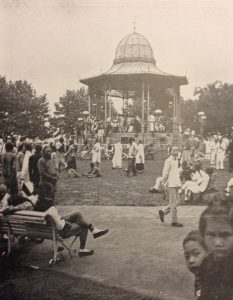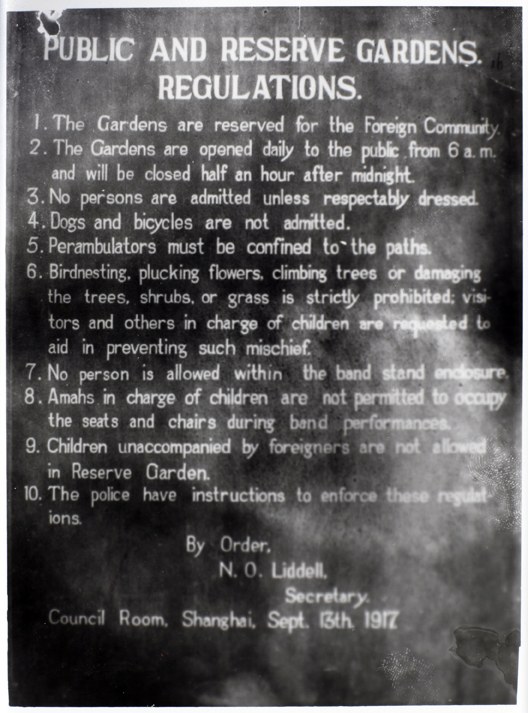
andstand, Public Gardens, Shanghai, 22 June 1911, by F. Mattos, source: private collection
This photograph appeared in a 1911 issue of the monthly magazine Social Shanghai, and shows the Bund-side Public Gardens crowded with Chinese visitors. The date is that of the coronation of King George V, and the original caption reads:
A Memorable Occasion
The Chinese were allowed to enter the Public Gardens for the first and only time.
Why did the journal print this photograph? It had a novelty value, certainly, for as many of this blog’s readers will know, and as the caption suggests, Chinese — excepting servants tending foreign children — were barred from using the public parks in the International Settlement at Shanghai. The rules were in fact quite blunt: regulation no.5 stated ‘No Chinese are admitted, except servants in attendance upon foreigners’ (a later, rephrased, iteration of these rules can be below). The racist exclusion of Chinese from the settlement parks, which lasted until June 1928, has been the subject of myth and fury since around the time this photograph was taken, and was the subject of a 1995 article I co-authored with Jeffrey Wasserstrom (someone has posted the PDF online here). For, in 1914, a story started circulating that the signboards stated things more baldly: ‘Chinese and Dogs not admitted’.

Public and Reserve Gardens Regulations sign, Shanghai, 1917. Bickers collection, Bi-s079: © 2008 Professor Bickers
Much attention has now been paid to tracing the trajectory of this tale, which remains unproven, though believed by many, but which also distracts attention from the more routine, bureaucratic realities of the egregious and pervasive racism of the foreign interests that controlled Shanghai. Based on our assessment of the archives of the Council itself, Jeff Wasserstrom and I concluded that we were dealing with an urban legend, albeit one which spoke to an essential truth.
The use by Social Shanghai‘s editor of this photograph is clearly designed not to document a novelty, but to reinforce this policy of exclusion. Look, reader, it says, ‘this is what will happen if the Chinese are allowed in’. There are many postcards of the Public Gardens in circulation, and we have various commercially produced as well as privately taken photographs of it (this shot of the entrance was taken in about 1910). In these, mostly, it is a picturesque sight, a place of quiet and reflection in the hurly-burly of Shanghai. Mattos’s photograph presents the nightmare of colonial power which has let slip its guard, and let slip the barriers and exclusions which define it.
The policy was the subject of debate within the foreign community, and was contested by Chinese political and commercial leaders, as well as by ordinary people. It became by the 1920s a very prominent issue, that did irreparable harm to the public image of the foreign authorities in Shanghai. Variations of the story live on today, and only this week a further twist was added to it, when a Beijing clothing store was found to have barred Chinese from entering (its customer base was in fact Russian). Commentators immediately drew attention to the history of exclusion in Shanghai, its legacy, and its lessons for ‘national dignity’.
The photographer, ‘F. Mattos’, was possibly Filomeno Mattos, who worked for the department store Weeks & Co, and who was a founder member of the Portuguese Company of the Shanghai Volunteer Corps. In the Shanghai context ‘Portuguese’ mostly meant Macanese, that is, the community of people of mixed Portuguese and Chinese heritage originating in Macao. They were as a result subject to their own exclusions and discrimination by the foreign power-holders at Shanghai, but these were far less easily caught on camera.

